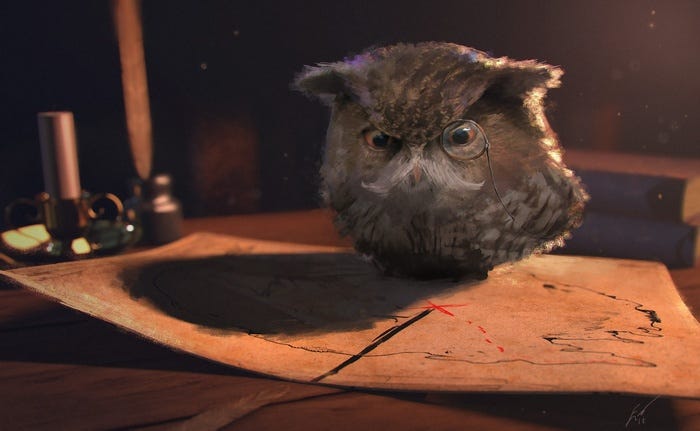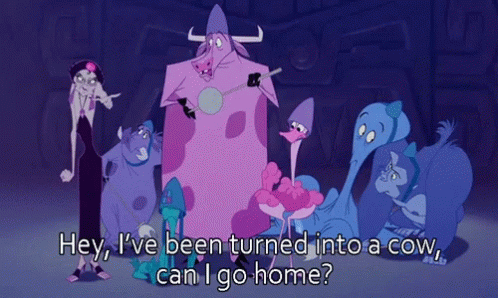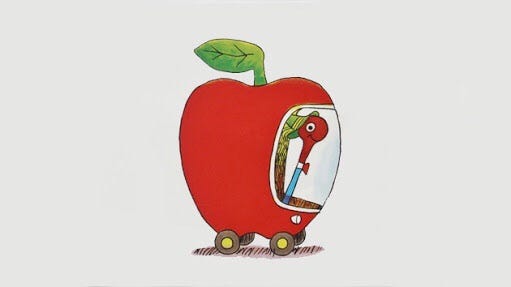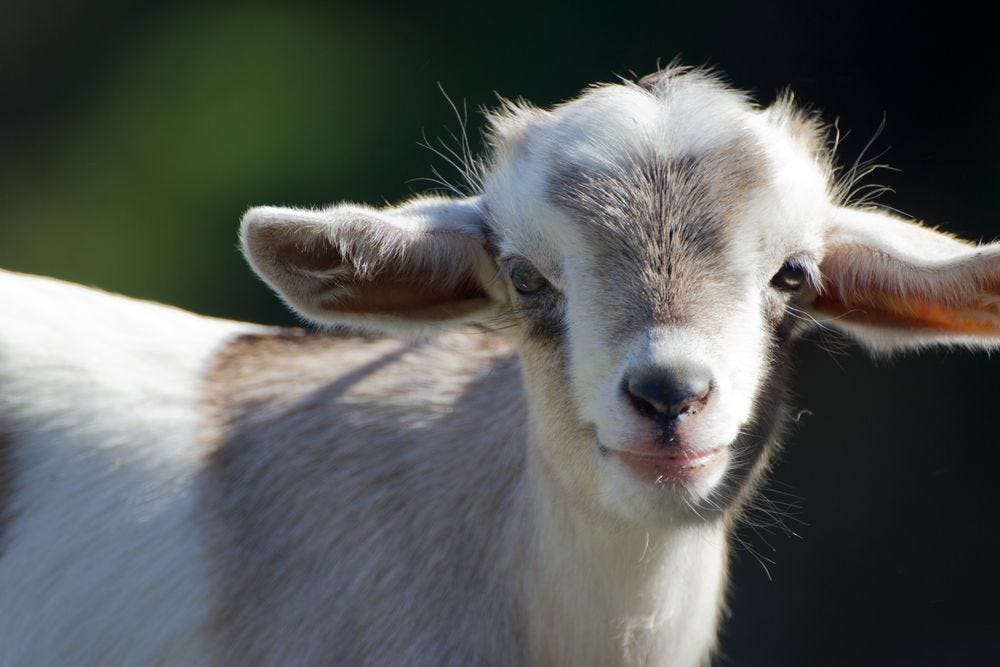PART 1: Moisturize Me
They wore white cloaks almost like choir robes, with pointed sleeves so long they brushed the tabletop… They put on white gloves of the type used to handle archival manuscripts and unfurled a scroll down the table’s length.
“Parchment,”said Darlington. “Made from goatskin and soaked in elderflower. A gift for the muse…”
Leigh Bardugo, Ninth House, p.100
Ask someone off the street what parchment is, and they’ll probably tell you “really old paper”. Maybe it’s crumbly, or crackly, or soft with age. Maybe it has visible fibers, or it’s heavy and thick and almost spongy, like that stuff you get at the stationery store that soaks up the ink from a ballpoint pen so thirstily that little lines feather out from the words as you write.
You know, Olden Timey. Something that someone with a big, fluffy feather quill would write important documents for the King on.
It’s the substance that makes up the cherished treasures of the very inner sanctum of many religions, from the Torah I read from at my bat mitzvah to the treasures around which much of the world of rare books and special collections revolves.
Try soaking parchment in elderflower juice, though, and you’ll soon discover why I almost titled this newsletter “I Can’t Believe It’s Not Jell-o”.
Parchment is essentially just a processed animal hide; a thin sheet of collagen, which, if heated and soaked, becomes gelatin, which, when ground up and added to some cherry (or elderflower) flavoring, would become Jell-o.

Sorry. Welcome to the Rare Commons: It’s gross here.
But that’s the whole point. Parchment is GROSS. You can soak and scrape and stretch a skin into a beautiful pristine polished writing surface, but at the end of the day if you get it the slightest bit wet it’s going to do its level best to turn back into a goat.
It’s an animal product, and because of that it requires deep care and specialized knowledge. Parchment leads us to confront the costs and results of using a particular medium in a very direct way.
So the idea of soaking a goatskin in elderflower might sound really evocative and mystical, but all it’s going to leave you with is a pile of fragrant goo that will eventually harden into The Worst Pork Rind. Maybe that’s what the muse likes, I don’t know.
PART 2: Classic Scrapes

This month’s newsletter looks not just at what parchment is, how it’s historically been used to make books in Europe, and why it fell out of favor, but also at what it can tell us about how we interact with media and information on a day-to-day basis.
Bardugo’s not a book history expert, and neither are her editors, and like most non-experts she conflates parchment with paper. Paper has its own fascinating history, but it’s a whole different text support.
(“Text support” is just a fancy term for anything that you write on, from the stone tablet a Druid would carve runes into, to the freshly painted wall your toddler is currently using to craft her magnum opus. It always tickles me because it sounds like we’re running around holding out a tray or a pillow, trying to catch words as they float down out of the sky. Gotta support that text.)
If you’ve ever tapped on a drumskin, you’ve got some idea of what parchment really feels like. Yes, that’s right, that beautiful illuminated book of hours glowing in the amber spotlight of the Fancy Museum has more in common genetically with a bongo than your family bible.
In parchment’s defense, you can’t use soft, fibrous, fancy writing paper as a jam-jar cover, or as grease-proof wrapping paper for candy, or soap, or as wallpaper or gun wadding or shoe-cleaner or as a last-minute washer on the blown gasket in your vintage Bugatti.
However, parchment, which cuts easily but is very difficult to tear, has been used for all of the above, at least according to Christopher DeHamel’s 1995 Sol. M. Malkin Lecture in Bibliography, Cutting Up Manuscripts for Pleasure and Profit. (You can, delightfully, listen to a recording of De Hamel giving this lecture on Soundcloud.)
The thing with parchment is, it’s animal skin. And unlike leather, which has undergone a tanning process that fundamentally chemically alters the protein makeup of the hide, parchment has just changed its shape, not its nature.
Meet Jesse Meyer. He runs the last artisanal parchment workshop in the U.S., and he’s going to show you exactly what goes into the parchment-making process.
It’s wild that I can show you someone making parchment using practices that haven’t changed in hundreds of years, but as he says in the video, Jesse reverse-engineered his process using historical sources and input from conservators. There are illuminated manuscripts from hundreds of years ago that show people using the same tools and materials to create parchment. Like this fun guy:

Because books made of parchment are fairly valuable and prized by the institutions that hold them, they’re often first up when it comes to digitization efforts. This means that we can look at some cool old books way up close, so you’ll see what I mean.
First of all, let’s look at what most of us think of as parchment, which is actually laid paper.
Below is a detail from page 152 of the Bodleian’s digital facsimile of the First Folio of Shakespeare’s plays (this is Act 1 Scene 1 of Hamlet). If you look closely, you’ll notice small, faint, horizontal lines distributed evenly across the page. These are left over from the papermaking process. Animal skins don’t usually have small even lines impressed into them (unless they have had a recent encounter with a grill).

This is a page from the Aberdeen Bestiary showing a Jesus who is demonstrating proper bowling form for these assembled rabbits and creatures that creepeth. You’ll notice that there are no horizontal lines visible at all, because it’s parchment.
At the bottom of the Bestiary page there’s a little oval hole. This is a spot where the person preparing the parchment has scraped the hide just a leetle too much, and nicked it. Because hides are scraped down, stretched, and scraped again over the course of several weeks, a hole that starts off small can get very big very quickly.
Sometimes these holes aren’t nicks, but bug bites, which I think is both gross and cute (kind of a theme for this newsletter.) For high-quality manuscripts like this one, though, my guess is that they would have used the very finest hides they could, not the buggy ones, especially for pages depicting God. So this is probably just some parchment-scraper’s bad day preserved forever. Hard luck, my dude.
(If you want to see more of the creative ways that manuscripts were repaired, this blog post from the Thaw Conservation Center at the Morgan Library has one of my favorite little 5-second videos demonstrating how scribes incorporated flaws in the parchment into their work. It would absolutely do numbers on TikTok.)
To the right of that hole, if you zoom in closely, you can see some very faint branching shapes, like forked lightning. Over the centuries, even the best-preserved vellum will warp and buckle and wrinkle, because parchment soaks up not just spilled liquid but water from the humidity in the air. Shapes like this, though, look to me less like water damage and more like the shadows of where the veins in the flesh of the animal would have been.
You can see more of them in the upper right of the Bestiary page, just behind the elephant, between the gloriously colored Loch-ness-monster-looking tail of what is actually the “D” in “Dixit” and the gutter (the middle part of the book).
To make parchment, you have to scrape both the hair off of the outside, and the flesh from the inside, which means you get some remnants either way: vein markings, or pores. The hair side is usually more matte, suedey and velvety, whereas the flesh side is brighter and smoother.
Not all parchment is created equal - some of it is beautifully thin and very white, including this 10th-century Gospel-book from Metz, held at the British Library. Zoom in to see just how clean and pure the page could get.
People have speculated that parchment was made from fetal calves to achieve this smoothness and thinness, but it was most likely split horizontally, because we just don’t have enough cows to afford killing them off in the womb, Jeanine. This 2015 write-up in the Guardian has more, if you’re interested.
In the Aberdeen Bestiary, the beginning pages that depict the creation of Adam and Eve are very fine, but by the time you get to the end where we’re talking about the properties of various stones, there’s a clearly visible grain layer with pores where the hair follicles used to be. Zoom in almost anywhere on that page and you’ll see some, especially toward the edges of the page - they look like little diagonal dashes, darker than the rest of the hide.
(The whole bestiary is worth a look-through, it’s just fun. At the bottom they have not just context and a summary of information, but if you click over a tab, a full transcription and translation of the words on the page, so you could read the whole thing cover to cover if you wanted to. You’ll never believe what an Eagle Stone can do.)
Most full hides of parchment were divided into three or four sheets for use as book pages. Sometimes, though, the full hide got used for a particularly large project, like a map, or this zodiac diagram from the 14th century.

You can see the echo of the animal’s body in the shape of the finished parchment, and the writer used the dimensions and idiosyncracies of the skin to organize his diagram.
Often, people get hung up on what kind of animals were used, but most often the answer is “whatever was around”, from cows to goats to sheep.
People also get hung up on whether the term “vellum” or “parchment” is more correct. Some people use “vellum” to refer to fine parchment made from cows (think “veal”), or to particular kinds of parchment bookbindings. Parchment is a pretty safe catch-all, though.
PART 3: Hey, I’ve been turned into a cow…
Any given book cost a certain number of cows, and of those cows only the choicest few with the whitest, most unblemished hides got chosen. Of those hides, only the ones that the preparator managed not to nick as he scraped them down or didn’t discard as bad splits got chosen for the holiest passages.
And that’s all before you get to the poor scribes, who certainly must have been feeling the pressure not to mess up too badly by that point. Imagine if I had to engrave this newsletter onto a Maserati — it wouldn’t happen. I’d have to go from town to town in a parade float shaped like Lowly Worm’s Applemobile telling you all about parchment from a megaphone.
Because of that preciousness, the technology of writing in Europe developed in a particular way, with its own conventions (remind me to get into scribal ligatures one of these days — ever wonder where ampersands come from?) that have been passed down to this day.
And this is all because of the nature of what parchment is, because it was a byproduct of one of the central ways to manifest your wealth (cows, I’m talking about cows). You can’t soak it in perfume without dire consequences because of it being MADE of cows, and it was so incredibly expensive because you NEEDED your cows.
Parchment is a particular medium with a particular set of benefits and drawbacks, just like any other. It’s really good for some things (creating a smooth, long-lasting, luminous writing surface that’s hard to tear) and not for others (getting wet, getting printed on, getting too dry, being vegan).
And, precisely because parchment’s not great to print on (although it can be done) and because it’s so expensive, paper completely changed the landscape of reading, communication, and media when it showed up in Europe.
The fact that we used to use parchment and don’t anymore is why it’s important to know about its particular characteristics, because they explain how and why it was used the way it was. It’s not inherently better or more precious than any other medium, but it isn’t just fancy paper, either.
PART 4: Exfoliation
Here’s a woodblock print of a parchment-maker from 1698, again doing basically the same thing as Jesse Meyer up there.

Notice anything weird?
He’s surrounded by the fruits of his labors, which are mostly drums, fans, and shades. There are a few leaves of writing parchment in the upper right, but the emblematic products of this guy’s craft are not books. By the late 17th century, when this illustration was made, paper had taken over book production in Europe.
This isn’t to say that parchment manuscripts weren’t still being produced, but mass production of manuscripts means a scriptorium full of expensive scriveners, several times the cost of a letterpress. They’re essentially the equivalent of Orville and Wilbur Wright in a glider plane going up against a Spitfire when it comes to the era of movable type. There’s just no competition.
Paper is cheaper, easier to make, and works better in a printing press with movable type. In the handpress period in Europe, the paper would be dampened with water and then oil-based ink would get pressed into it, making an indentation into the soft fibers. It’s not to say that people didn’t print on parchment, but at the end of the day ink tends to glide over parchment, rather than sinking into it the way it does into paper.
The only documents I know of that are still printed on parchment regularly are Acts of Parliament in the UK, and the Duke and Duchess of Cambridge’s wedding certificate. Parchment is also still used as a text support for religious books, as well as in art, furniture and decoration.
PART 5: The G.O.A.T.
The point of this all, for me, is that you can make any number of pricelessly beautiful books, but it’s important to remember that every text support we use has a visceral and very real connection to the physical world, from the veins a monk scraped off the skin that would become the Aberdeen Bestiary centuries ago, to the lithium getting mined by children in Bolivia that powers the smartphone you’re reading this on.
And that’s a central theme of this newsletter — thinking about what different media do and how, remembering that we develop tools that are the products of choices made by people, not happenstance or divine intervention.
For example, Apple products are named after something natural, simple, and whole, which signals the idea that the digital world is clean, self-evident and easy, whether or not that’s the case. (It’s not.)
Don’t make the mistake of thinking that because these manuscripts are digitized that they’re somehow preserved forever. Digital resources require time and attention (read: $$$) to be maintained through the relentless march of formats and upgrades that’s inherent to this medium.
Similarly, parchment signifies. And listen, this isn’t the Cancel Leigh Bardugo Variety Hour. The characters in Ninth House (which is wildly entertaining, deeply spooky, and very timely, go get it from your nearest independent bookseller) are preparing a ritual to replace a struggling writer’s blood with enchanted ink so he can write his next great novel. Verisimilitude is not the order of the day.
But to 21st-century eyes the very word “parchment” seems old, heavy, redolent with tradition and meaning that’s inherent in the material itself, without regard for what that material actually is or how it works.
Indeed, the whole point of dressing up her cultists in flowing white robes and having them don “gloves of the type used to handle archival manuscripts” is to emphasize the separation between the mundane world and the holy world of arcane ritual, and the word “parchment” is part of that world-building.
I honestly think this is a big part of why people get so angry that librarians and archivists don’t use white gloves as a rule when handling materials — it’s less about the appropriateness of the tool…

…and more about the appropriateness of the approach to what is seen as a sacred, sacramental text, just because it’s old and considered precious. How dare our humdrum paws directly touch something that was made centuries ago without some kind of ritual barrier?
I’m not saying we shouldn’t be in awe of the kind of fancy old books that people think of when they think of rare books and special collections. Examining a book created before the era of mass production is like being able to pick up and examine an entire symphony orchestra with your hands, and the only way to be able to keep doing that is to do so with care and respect.
The point isn’t that books aren’t special — it’s that they’re special because of what we can learn from them, which includes thinking critically about what they signify to us.
Gloves and sleeves and elderflower cordial create a separation between us and the reality of the materials that leaves us seeing them only as “special”, rather than as a key to our own understanding of ourselves and the way we communicate.
It’s still happening today: “bookishness” (Twitter arguments about how you organize your bookshelves, buying a scarf with the entirety of Alice in Wonderland printed on it) is a way of seeing physical books primarily as cultural artifacts that, not coincidentally, happens almost entirely online.
We’re very adept at setting older media at a remove from our everyday practice as soon as that practice starts to shift, as parchment shifted to paper and as physical books are shifting to digital ones. But it’s important to remember that those older media never fully pass out of use, and that they represent not just cultural cachet but information about how we communicate. Parchment matters not just as an exercise in recreating a lost craft, but in thinking about how our own information landscape is always changing.
I guess this is all to say that when we misremember parchment, we take our current media for granted. Memento that you must mori, and memento that everything you use to communicate and create exists as and comes from a real thing in the real world - not some pristine factory, not The Matrix, not Janet’s Void. We are Wall-E, not EVE.
NEXT TIME: SLOW YOUR ROLL, COMING AUGUST 4
NB: Download the entire e-mail for further reading and works cited!
Works Cited
THE BASICS
If you’re ever looking for well-researched information about almost any subject, my go-to advice is always to search “whatever subject” + libguide in Google - chances are, some hardworking person has put together a guide of various reputable sources about whatever you’re looking up.
For example, this great libguide from Mizzou led me to a fun video where Erik Kwakkel walks you through listening to various books made with parchment - you can really hear the difference between high-quality and low-quality vellum.
The ABAA has a nice quick rundown of the history and use of vellum and parchment.
If you’re looking for a really readable breakdown of parchment in layman’s terms, this excerpt from Keith Houston’s The Book is a fun read.
Eric Kwakkel also did a fun blog post for Khan Academy with a good overview, plus some nice close-ups of the grain and pores, as well as stitches, rips, holes, and doodles.
CONSERVATION AND CLOSEUPS
Here’s looking at you, kid, is a hilarious title that I blatantly stole from this fascinating blog post from the British Library on the difference between leather and parchment, and on the different conservation challenges of various leather bookbindings. The red rot alone should have people thinking twice about wearing flowing white robes to the reading room - I’ve more than once been left walking around with rust-colored stains around the middle from bringing books back and forth from the vault.
If you’re interested in conservation challenges around parchment, this post from the British Library is a good place to start.
Everything you could ever want to know about parchment in your whole life, from a conservator’s point of view.
For a nuts-and-bolts description of how parchment’s structure differs from leather, try the entry for parchment in Bookbinding and the Conservation of Books, A Dictionary of Descriptive Terminology, which can be found at HathiTrust but I find more readable at CoOL.
If you want to look at more different kinds of pores than Dr. Pimple-Popper, Traveling Scriptorium has you covered with the library equivalent of looking in a magnifying mirror for too long.
Similarly, the Codex Sinaiticus blog will help you tell the difference between calfskin and sheepskin parchment at 100 paces.
TOUCH, LOOK, AND LISTEN
De Hamel, Christopher. Cutting Up Manuscripts for Pleasure and Profit. The 1995 Sol. M. Malkin Lecture in Bibliography. Charlottesville, VA: Book Arts Press, 2011. Unfortunately this might be hard to get hold of if you’re not near an academic library, but you can listen to it for free, along with plenty of other fascinating lectures, on the Rare Book School Soundcloud page.
Examples from the British Library, including this 10th-century Gospel-book from Metz, show you just how clean and pure the page could get. Make sure to zoom in.
This LibGuide from Santa Clara University features a great video with an English guy making parchment for the BBC, which gives you some secondhand idea of the smells and textures involved.
If you’re interested in learning more about Pergamena, they can be found online at www.pergamena.net or @pergamena_ny on Instagram. They run workshops as well, if you want to try your hand at parchment-making yourself.
BONUS READS
If you’re interested in reading Ninth House by Leigh Bardugo, I can’t recommend it highly enough, despite my nitpicking: Bardugo, Leigh. Ninth House. New York: Flatiron Books, 2019. Citation is from the hardback edition.
Also, go ahead and pick up a copy of Classic Scrapes by James Acaster, a delightful shenanigans-based memoir that includes the evocative phrase “We’d Lost a Bongo”, which I desperately wanted to make the header of the last section of this newsletter but it’s a bit of a deep cut.
A 2015 write-up in the Guardian debunking the use of uterine vellum, but the sheets of ultra-fine parchment used in smaller books are still a matter of wonder and debate.
Most full hides of parchment were then divided into three or four sheets for use as book pages. Sometimes, though, the full hide got used for a particularly large project, like a map, or this zodiac diagram from the 14th century. Diagram comes from this blog post: Holcomb, Melanie. “From Animal to Art: The Story of Parchment.” Pen and Parchment: Drawing in the Middle Ages. (/penandparchment/). The Metropolitan Museum of Art. Blog. 5 July 2021.











I would love to read a post about manuscripts *on paper*-it seems like they don't get a lot of attention even though 1) there was IIRC in a lot of places a pretty long gap between the introduction of paper and rise of print and 2) you have post-medieval paper MSS for private use it would be interesting to read about.